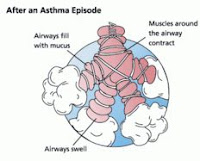 A 2-week, multicenter, double-blind trial was conducted during the Texas mountain cedar season -- 151 patients were randomized to treatment with:
A 2-week, multicenter, double-blind trial was conducted during the Texas mountain cedar season -- 151 patients were randomized to treatment with:1. azelastine nasal spray, 2 sprays per nostril twice daily
2. fluticasone nasal spray, 2 sprays per nostril once daily
3. azelastine nasal spray, 2 sprays per nostril twice daily, plus fluticasone nasal spray, 2 sprays per nostril once daily (the combination)
The efficacy was measured by the change in the total nasal symptom score (TNSS), consisting of sneezing, itchy nose, runny nose, and nasal congestion.
All 3 groups had improvements from their baseline TNSS, 27% with fluticasone, 25% with azelastine, and 38% with the 2 agents in combination, respectively.
The authors concluded that azelastine and fluticasone combination may provide a therapeutic benefit in seasonal allergic rhinitis compared with therapy with either agent alone.
This finding is in contrast with previously published studies that found no advantage from using the combination of an oral antihistamine and steroid spray. Two sprays seem to work better than a spray and a pill.
Patients should be instructed to angle the fluticasone spray towards the ear to direct it where the inflamed nasal mucosa is. Pumping it straight up will direct the medication to the nasal cartilage, leading to local side effects.
Azelastine-Fluticasone nose spray (Dymista) is effective for allergic rhinitis and is awaiting FDA approval (http://goo.gl/QbbDl and http://goo.gl/8DPwY).
A 2014 study showed that Dymista (FP and AZE) was twice as effective as AZE or FP for allergic rhinitis, 7 out of 10 patients became symptom-free after 1 month of therapy http://buff.ly/1dEajBO
References:
Combination therapy with azelastine hydrochloride nasal spray and fluticasone propionate nasal spray in the treatment of patients with seasonal allergic rhinitis. Annals of Allergy, Asthma and Immunology, 2008, vol. 100, no. 1, pp. 74 - 81.
Azelastine Plus Fluticasone Nasal Spray Effective for Seasonal Allergic Rhinitis. Medscape, 01/2008.
Image source: Azelastine, Wikipedia, public domain.
Related reading:
New tools help MDs treat allergies. National Review, 03/2008.
Positive study results for combined INS/INA spray for allergic rhinitis, Dymista, fluticasone/azelastine http://goo.gl/d6RZ7
Combination nose spray azelastine plus fluticasone works better than individual components in allergic rhinitis. JACI, 2012.
Combination nose spray azelastine plus fluticasone works better than individual components in allergic rhinitis. JACI, 2012.











.jpg)









